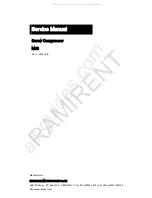
Drain Valve
1/4” FNPT
Model Number RL12S
Bootstrap Compressor • Installation and Operating Instructions
Midwest Pressure Systems, Inc.
RAV
Rev. 0
MPS
M I DW E ST
PRESSURE
SY S T E M S
MPS
M I D W E S T
PRESSURE
S YS TE M S
MPS
M I D W E S T
PRESSURE
SY S T E M S
MPS
M I D W E S T
PRESSURE
SY S T E M S
MPS
M ID WE ST
PR ESSURE
SYS T E MS
MPS
M I DW E ST
PRESSURE
SYS T E M S
MPS Logos
12/5/91
1/2" Square
3/4" Square
1" Square
1-1/4" Square
1-1/2" Square
2" Square
MPS
M ID WE ST
PR ESSURE
SYS T E MS
Mount the Model RL12S Bootstrap Compressor on a horizontal
surface. Other mounting orientations are not recommended.
The booster system vibrates while operating, so use the four 1/2”
mounting holes, shown in the diagram to the right, to bolt it to a
solid surface.
1
Connect your shop air line to the 1/4” FNPT air inlet filter on the
front of the booster. A shutoff valve can be installed upstream of
the filter for convenient removal of the system for maintenance.
The booster has a built-in discharge pressure regulator. Do not
install a supply pressure regulator. Lowering the supply pressure
reduces the efficiency of the system. The unit is permanently
lubricated.
Use of an inlet lubricator will void the
warranty. The maximum inlet pressure is 150 psig.
2
Attach discharge line to the 1/2” FNPT port on the left side of
the receiver tank.
If the application requires a
lubricator, make sure the lubricator is installed
downstream of the booster.
A filter should be installed to
protect downstream components from seal/booster wear
particles.
3
The discharge pressure regulator is set by the black, snap-
lock knob mounted on the top of the unit. Pull up on the knob
to unlock it. Adjust the knob by turning it clockwise for a
higher discharge pressure (up to a maximum of 230 psig), or
counterclockwise for a lower discharge pressure. Inlet
pressure is read on the gauge closest to the inlet connection.
The second gauge indicates discharge pressure. Supply shop
air to the booster and it will start to operate. Set the regulator
to attain the desired discharge pressure, and push down on
the regulator knob until it “clicks” to lock the regulator on
that setting. The regulator is self-relieving. When the
discharge pressure setting on the regulator is reduced, the
higher pressure stored in the system will vent through the
regulator until pressure equilibrium is reached.
If the inlet
pressure is higher than 115 psig, it is possible to
set the regulator so the booster exceeds the
maximum discharge pressure of 230 psig. Do not
operate the booster under these conditions. It is
designed to operate continuously at a maximum
discharge pressure of 230 psig.
5
The Bootstrap Compressor will operate as long as there is
demand for high pressure air. When there is no demand, the
booster will “stall” at the pressure set by the discharge regulator.
The stalled condition consumes no energy and does not damage
the booster. The booster will start up automatically when the
pressure falls slightly as a result of demand for high pressure air.
7
Mounting Bolt Pattern:
16.5”
10”
Inlet port
1/4” FNPT
Discharge port
1/2” FNPT
The accumulator tank has a 1/4” ball valve to drain condensate. A
drain line or automatic drain valve can be attached to this valve
when needed. Close the valve before starting booster.
4
The accumulator is rated for 235 psig and includes a relief valve
set for 235 psig.
This relief valve was selected to prevent
operation of the booster above its maximum
allowable discharge pressure of 230 psig.
8
For more precise booster control, set the discharge regulator for
a higher pressure than required, and install a filter and secondary
regulator on the discharge line of the accumulator. This allows
for greater accumulator storage capacity, and minimizes pressure
fluctuations in the system. For maximum high pressure air
storage, Bootstrap Compressors are set to charge the
accumulator to 230 psig, and the secondary regulator in the
discharge line of the accumulator is set at the desired, lower
pressure. Make sure that any downstream components are rated
for the accumulator pressure, or are protected by a relief valve in
case the secondary regulator fails.
6
235 psig
Pressure
Relief Valve
Midwest Pressure Systems, Inc.
850 Transport Drive, Valparaiso, IN 46383
Phone 219-462-0070




















